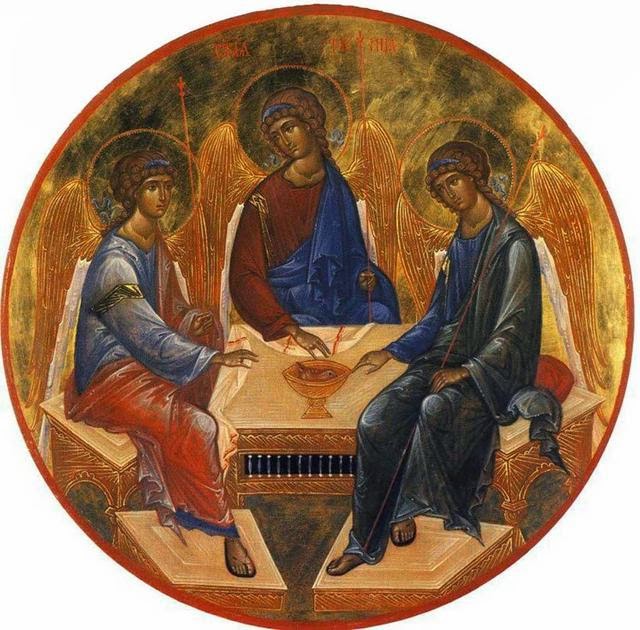This Sunday we celebrate the Solemnity of the Most Holy Trinity. Most of us have been done a great disservice in being told that the Trinity is a mystery you cannot understand, you just have to accept it. What this does is often prevent any understanding we could have of the Mystery and any further thought about this mystery of the Triune God as being meaningful for our ordinary lives.
I do not expect to fully understand how God is "One God in Three Persons," for God transcends our limited understanding. I will tell you, however, that the Trinity is a mystery (i.e. deeply, inexhaustibly meaningful) which we can understand, but in a limited human way, and in understanding the mystery of God as Father, Son, and Holy Spirit, we can affirm with the Catechism that
"The mystery of the Most Holy Trinity is the central mystery of Christian faith and life. It is the mystery of God himself. It is therefore the source of all the other mysteries of faith, the light that enlightens them." (Catechism #234)
God is love. The same "key" that unlocks the meaning of Christ’s Paschal Mystery (his dying and rising which become in the Spirit the pattern of our lives) also "unlocks" for us the meaning of God’s "innermost reality" as Triune: that key is that "God is love." (1 John 4:8)
The Catechism joyfully teaches:
"God’s very being is love. By sending his only Son and the Spirit of love in the fullness of time, God has revealed his innermost secret: God himself is an eternal exchange [sharing, giving, receiving] of love, Father, Son, and Holy Spirit, and he has destined us to share in that exchange." (Catechism #221)
Love is a reality of oneness, union, and yet is communal, involves many. And what the mystery of the Triune God reveals to us is that "God is one but not solitary" (Catechism #254). As we shall see, neither are we created to be solitary.
God is one God in Three Persons who is eternally sharing, giving, and receiving all love between the Father, Son, and Holy Spirit. The essential being of God is relational and all creation mirrors that reality is relationship.
Implications of the Relationships and Communion of the Trinity for our lives. Only a few ‘teasers" can be given in summary form of what it means for our lives that God is One in Three, Unity and Diversity, Community and Communion of Love:
 |
| Edward Hicks, "Peaceable Kingdom" |
(1) The fundamental source of all created reality is a Creator-God who is relational (God’s very being is relationship: between Father, Son, and Holy Spirit); thus all creation is relational. In a most poetical passage of the Catechism is found this statement:
"The sun and moon, the cedar and the little flower, the eagle and the sparrow: the spectacle of their countless diversities...tells us that no creature is self-sufficient. Creatures exist only in dependence on each other, in the service of each other." (Catechism #340)
(2) Humanity is created in the image of God, the God who is the divine Community of Three Persons, one God, who is love. Thus, we are most "in the image of God" when we live in community with one another, as persons.
"The most pernicious heresies that block us from properly knowing God are not those of formal dogma, but those of a culture of individualism that invite us to believe that we are self-sufficient, that we can have community and family on our own terms, and that we can have God without dealing with each other. But God is community–and only in opening our lives in gracious hospitality will we ever understand that." (Fr. Ron Rolheiser, "Finding God in Community.")
(3) Any community in the image of God will seek unity, yet at the same time include diversity. Just as God can be One in Three, so we can be one in many (by God’s grace). The distinctiveness of each person in a community must be respected, and persons can be unified without having "to be exactly like one another."
(4) The "exchange of love" of the Three in One God is always giving and receiving. We are most in the image of God when in our families, parishes, marriages, work, we seek (again with God’s love) to give and receive love.
(5) Ultimately, it is only by living the Paschal Mystery–the dying and rising of Christ in the Spirit–that we can live in the image of God as Community of Love.
But this dying, this sacrifice for love, empowered in us by the Holy Spirit, is the way to Resurrection, a new creation, "life in the Most Holy Trinity and with one another." Beginning with love and ending in love, we begin to be transformed in love, i.e. in the God who is love, and we can understand something of the Triune God. This "Mystery of Love" is God’s Gift and Life in us, in Christ Jesus. As St. Augustine said, "Show me one who loves, and he [or she] will understand!"




